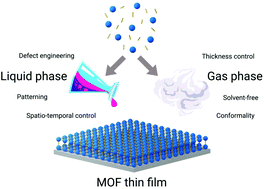Advanced technologies for the fabrication of MOF thin films
Abstract
Metal–organic framework (MOF) thin films represent a milestone in the development of future technological breakthroughs. The processability of MOFs as films on surfaces together with their major features (i.e. tunable porosity, large internal surface area, and high crystallinity) is broadening their range of applications to areas such as gas sensing, microelectronics, photovoltaics, and membrane-based separation technologies. Despite the recent attention that MOF thin films have received, many challenges still need to be addressed for their manufacturing and integrability, especially when an industrial scale-up perspective is envisioned. In this brief review, we introduce several appealing approaches that have been developed in the last few years. First, a summary of liquid phase strategies that comprise microfluidic methods and supersaturation-driven crystallization processes is described. Then, gas phase approaches based on atomic layer deposition (ALD) are also presented.



 Please wait while we load your content...
Please wait while we load your content...